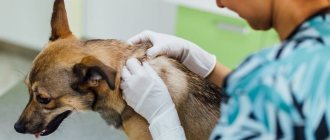German Shepherds are one of the smartest and most loyal dogs in the world, delighting their owners with energy and endless love of life throughout their lives.
However, before purchasing a puppy, you should find out about the health characteristics of representatives of this breed.
In particular, their hind legs often fail.
And in this situation, you need to know how to help your pet.
What problems can your pet encounter?
Chronic musculoskeletal problems
Chronic diseases of the musculoskeletal system include:
- dysplasia of the hip or elbow joint - most often a genetic pathology associated with abnormal development of the joint;
- knee dysplasia is a congenital joint disease in which malformations lead to damage to bone and cartilage and, as a consequence, osteoarthritis;
- panosteitis (pano) is a pathology called “wandering lameness” and is characteristic of puppies 5-12 months old.
It is also possible to develop arthrosis and arthritis.
Reasons for refusal
Impaired performance of the musculoskeletal system of German Shepherds can be caused by various diseases.
Dysplasia
A chronic pathology in which destruction of joints, ruptures of bone tissue and cartilage occurs.
If we are talking about an acquired disease, then it develops as a result of improper diet , obesity , deficiency or excess of vitamins and minerals, as well as due to serious physical activity in the puppy.
In cases where the disease is hereditary, animals have congenital abnormalities in the structure of the joints.
NOTE!
Symptoms appear only when the puppy reaches six months of age.
A sign of dysplasia is a hunchback instead of a smooth line.
Spinal diseases
As a result of bruises, as well as with discopathy, spondylosis, spondyloarthrosis and osteochondrosis, the fibrous rings are damaged, swelling and compression of the spinal cord and peripheral nerves are observed.
All this leads to the death of cells of the nervous system, which manifests itself in weakness of the limbs: from lameness to complete failure..
In some cases, spinal injuries can cause complete paralysis of the hind legs.
Oncology
Malignant or benign neoplasms on the brain or spinal cord, paws or spine can also cause malfunctions of the musculoskeletal system - tumors put pressure on the tissues and structure of the central nervous system.
There is a possibility of finding small swellings on the paws of older German Shepherds, and the dog may be limping and dragging its limbs.
If the tumors are localized in the spinal cord or brain, the German Shepherd experiences severe pain and paresis or complete paralysis of the limbs is noted.
Injuries
Injuries to the limbs, head, or spine sustained by a German Shepherd during play, fighting, walking, or an accident are another possible cause of hind leg failure.
In addition, any awkward movement, jump or fall of the dog can lead to a fracture, sprain, ruptured tendon or pinched nerve..
Expert opinion
Kozhevin Semyon Kirillovich
Expert dog handler.
German Shepherds are prone to developing diseases associated with the musculoskeletal system, therefore, first of all, they need a set of preventive measures to avoid limb failure. However, this can often be the result of a hereditary disease, when it is impossible to avoid the consequences. At the first signs of limb failure, you should immediately contact a veterinarian - only a specialist can carry out the necessary diagnostics and prescribe treatment. Remember - self-treatment will most likely be incorrect and can lead to death.
What to do?
If the dog begins to pull its hind legs, you need to take this problem very carefully. In most cases, the problem of hind leg failure cannot be solved without the intervention of a veterinarian, and excessive delay in contacting the clinic can lead to negative consequences. What to do if your pet starts pulling its hind legs?
- Analyze what exactly could have caused the failure of the hind legs in order to give the most accurate answer during a consultation with a veterinarian. You need to consider whether your pet has had any injuries or recent illnesses. Any information that may be even slightly related to the occurrence of such a problem should be reported to the doctor.
- Contact a veterinary clinic. Whatever the reason for the failure of the hind legs, it is simply necessary to consult a veterinarian. Perhaps problems with paws are just a symptom of some more serious disease. Therefore, you should not put off visiting a doctor.
- Analyze dog nutrition. One of the most common causes of problems with the hind limbs is an incorrect diet (with an excess of protein, calcium, phosphorus, etc.). In the early stages of many diseases, nutritional correction can help get rid of the problem. Of course, before making any changes to your pet's diet, you should consult your veterinarian.
If your dog is pulling his hind legs, you should contact your veterinarian to determine the cause of the limb failure. If you provide your pet with quick and high-quality treatment, you can avoid the development of many serious diseases!
Many people say “it will heal like a dog” and they are very mistaken, since these cute animals, just like people, are not protected from diseases, including those related to the musculoskeletal system.
There are situations when a dog’s front or back legs begin to fail. Why this happens and what influences the appearance of this ailment can be found in this article.
Symptoms of pathology
The fact that a German Shepherd's limbs are failing can be judged by the following symptoms::
- the dog squats on its paws, limps, while moving, the limbs remain straight and do not bend at the joints;
- the pet whines and squeals during movement due to severe pain;
- rapid breathing and convulsions are observed;
- swelling forms on the paws in the area of the joints;
- the animal prefers to lead a recumbent lifestyle or, on the contrary, behaves restlessly;
- in some cases, the German Shepherd cannot stand on its paws and drags them behind itself when moving;
- It is possible that aggression may occur when the owner or doctor tries to examine the hind legs or simply touch the back.
The earlier the pathology is diagnosed, the higher the chances of a positive outcome of therapy, so it is important for the owner to know about the symptoms of the disease.
Video: Paralysis of the hind legs in dogs
If your pet cannot walk due to paralysis of its hind legs, all is not lost. There is always hope!
German Shepherds at any age delight their owners with their cheerfulness, the ability to frolic for hours in active games, as well as their gracefulness and smooth movements. Quite often, a German Shepherd's hind legs fail. The problem of limb weakness is observed not only in older pets, but also in very young animals. If a dog falls on its hind legs, it is necessary to take the animal to a veterinary clinic as soon as possible. There are many reasons for limb weakness in puppies and adults. A sick dog requires a comprehensive examination to establish a diagnosis and prescribe appropriate treatment.
Harbingers of paw failure
The first signs of limb failure can vary depending on the cause.
So, with dysplasia, you need to pay attention to:
- lameness;
- instability of the paws and, as a result, an unsteady gait;
- fatigue;
- heavy lifting from a lying position;
- audible cracking of joints.
In case of injury, the damaged area swells, hematomas form, the dog experiences pain and whines, squeezing its paw.
CAREFULLY!
With pathologies of the spine, the dog shuffles and limps, and over time the limbs fail completely.
Under no circumstances should changes in the dog’s behavior or mood be ignored - even seemingly insignificant moments may turn out to be the first signs of a serious pathology.
Symptoms may appear gradually, replacing or complementing each other, or appear suddenly.
Symptoms of Hind Leg Failure in Dogs
The first and most common symptom that precedes hind leg failure in dogs is pain. This is often associated with a neurological disorder in the spinal column, so the animal will experience pain and discomfort especially when moving or suddenly changing position. A little later, muscle weakness and lack of nerve impulse may occur, as a result of which the pet cannot move. After this, all pain sensitivity disappears and the dog, roughly speaking, no longer feels its limbs.
It is important to note that all of the above symptoms can either increase gradually, appearing after a certain time, or arise suddenly, for example, during a walk. The occurrence of all these symptoms can be caused by a sudden movement during the game or a sharp push. Also, initial symptoms can very quickly develop into complications. For example, in the morning a dog may feel pain, and by the evening its hind legs may be paralyzed.
No dog owner is immune from such an unpleasant disease, but breeds with elongated bodies, for example, dachshunds, as well as brachycephalic breeds (pugs, Pekingese and others), are especially at risk.
Why are people rejected at puppy age?
Weak joints and muscles are a feature of the physiology of German Shepherd puppies.
Often between the ages of 3 months and 5 months they may notice :
- lameness;
- falling on your hind legs or pulling them up when walking;
- X-shaped paw set;
- squatting on limbs.
If any of these manifestations of weakness of the limbs and muscles occur, it is necessary to take your pet to a veterinarian..
Based on the results of the examination and tests, the doctor will prescribe medications and make recommendations regarding a diet and training that will help build and shape the muscle corset and strengthen the musculoskeletal system.
If limb failure is the result of joint or central nervous system pathology, the success of the therapy depends on how quickly the correct diagnosis is made.
How to tell if your German Shepherd is losing its paws
Problems with the hind legs of German Shepherds arise due to the animals’ genetic predisposition to pathologies of the musculoskeletal system. Sometimes the cause of limb dysfunction is cancer or diseases of the central nervous system. You can understand that your beloved dog’s limbs are failing by the characteristic clinical picture:
- a graceful animal walks poorly, there is lameness or movement on straight limbs without bending the joints, squatting on its paws;
- if a pet’s paws are very sore, then the animal whines, squeals when moving, prefers to lie with an elongated neck and a hunched back;
- convulsions and shortness of breath are often observed, the dog’s limbs are shaking;
- swelling occurs on the limbs in the joint area;
- sometimes the pet does not stand on its hind legs and drags its limbs.
If your German Shepherd has difficulty getting up from a lying position, limps, gets tired quickly, or you can hear cracking joints, you should urgently undergo an examination at a veterinary clinic.
It is necessary to treat an animal with symptoms of a musculoskeletal system disorder only in a veterinary clinic. Self-diagnosing pathology and prescribing medications can aggravate the situation.
Diagnostic methods
Making a diagnosis includes a set of the following measures::
- general examination;
- taking anamnesis;
- laboratory tests of blood, urine;
- Ultrasound and X-ray;
- MRI and CT using contrast agent;
- checking reflexes and paw sensitivity.
Depending on the results of the examination, a diagnosis is made and drug treatment is prescribed or a decision is made on the need for surgical intervention.
What to do if your dog's paws fail?
Naturally, the most effective way is preventative action. However, if the dog exhibits a similar symptom, it is necessary to call a veterinarian and provide first aid, namely:
Immobilize the dog by tying it to a board;
Under no circumstances should painkillers be given because the cause of the symptom is not known.
The most important thing to do is to wait for a specialist who will conduct a thorough examination of the pet, determine the presence of sensitivity and pain in the spine, and also prescribe the necessary treatment and tests.
Depending on the severity of the disease, the veterinarian may insist not only on drug treatment, but also on surgical intervention. There are often cases when even the most hopelessly ill dogs, after complex therapy, got back on their feet and became completely healthy.
Very often on dog breeders’ forums and in requests to veterinarians, you can come across a group of questions related to the problem when dogs’ hind legs fail. This problem is in most cases associated with neurological abnormalities and small and medium-sized dog breeds are especially susceptible to it. However, these are not all the reasons for such a terrible consequence; it happens that, for example, a dog falls on its hind legs for no apparent reason. Why this occurs, what to do and what treatment is needed, we will consider in this article.
[Hide]
How to avoid problems for a puppy
To strengthen your puppy’s muscles and ligaments, you should follow these recommendations::
- before the dog turns 1.5 years old, it is necessary to give it cottage cheese and other fermented milk products, as well as vitamins and nutritional supplements containing calcium, but strictly in the dosage recommended by the veterinarian;
- supplement the puppy’s diet with preparations containing glucosamine and chondroitin;
- observe the feeding regime and the principles of a balanced diet;
- provide your pet with moderate physical activity that promotes the formation and strengthening of the muscles of the limbs;
- eliminate the possibility of overfeeding the dog, leading to obesity and increasing the load on weak paw muscles.
It is also important to ensure that the place where the puppy plays has a smooth, non-slip surface and is free from drafts..
Treatment regimen
| The cause of the pathology | Treatment |
| Dysplasia | At an early stage of the disease, a diet, restriction of physical activity, taking chondroprotectors and painkillers, and a course of physiotherapy are prescribed. In severe cases of the disease, surgical intervention will be required, which will involve resection arthroplasty and triple osteotomy. |
| Oncological diseases | If, as a result of the examination, it is determined that the tumor growing in the spinal cord or brain is malignant, then medicine is powerless. One option is to euthanize the dog. Otherwise, it is possible to use painkillers and hormonal drugs to maintain the life of the pet. |
| Injuries | Treatment is prescribed based on the nature of the damage. For bruises, sprains and closed fractures, the doctor uses fixing bandages and prescribes painkillers and a course of physiotherapy; for dislocations, the joints are set; for open injuries, surgical intervention is necessary. If the integrity of the spinal cord or brain is damaged, it is impossible to cure a German Shepherd. |
| Spine pathologies | Depending on the stage of the disease the German Shepherd was diagnosed with, the pet will be prescribed anti-inflammatory, painkillers and hormonal medications, and complete rest is recommended. In some cases, surgery is required. |
Treatment of this pathology requires a lot of effort and time, and its success depends not only on the competence of the doctor and the speed of diagnosis, but also on the age of the dog, the severity of the injuries and the presence of concomitant diseases.
Treatment
Of course, in order to help your pet, you need to know exactly the cause of the disease, and for this you need to contact a veterinary clinic. It is advisable to get an appointment immediately with a doctor specializing in neurology. Even simple lameness or difficulty getting up can be a reason to visit the veterinarian. Do not think that this is a short-term phenomenon that will go away on its own. It’s good if so, but this could also be the first sign of very serious illnesses.
If your pet is injured, jumps unsuccessfully, or pulls a muscle, do not delay going to the veterinarian. Only competent treatment can save the dog from subsequent negative manifestations. It is strictly forbidden to use painkillers without a doctor's recommendation. Moreover, the pain will limit the animal’s movement, which means the risk of even greater injury will be eliminated.
Remember that only a timely visit to a specialist and a competent approach to treatment will help to fully get the dog back on its feet. Otherwise, help may be ineffective and then your pet will only have one sentence - a stroller. Depending on the diagnosis and cause of the disease, the veterinarian may prescribe treatment with medications, massage, certain physical activities, diet, etc.
First aid for a pet
Regardless of the nature of the injury, its extent or signs, it is important to get your pet to the clinic as soon as possible. At the same time, you cannot force him to walk if his motor function is still possible. Pick up the dog or place it in the car and take it to the veterinarian. The specialist must establish the integrity of paw sensitivity, check for pain, the presence of injuries and pathologies. The doctor may also take blood and urine tests for additional information.
If your dog's back legs are giving out, you should restrain him on a strong, hard surface. Any medications, including painkillers, cannot be given. It is important to carefully deliver the dog to the veterinary clinic as quickly as possible without unnecessary shaking.
As for the veterinarian's advice, it all boils down to a couple of very basic rules:
- do not engage in treatment on your own, do not undertake any courses or methods of treatment on your own;
- an experienced specialist should do an x-ray and myelography to assess the situation;
- carry out timely prevention especially for those dogs that are by nature prone to spinal pathologies and dysplasia.
Prevention
In order to prevent limb failure, it is necessary:
- up to 1 year constantly, after that - from time to time give the pet chondoprotective drugs;
- up to 12-16 months, exclude the possibility of the pet jumping from great heights;
- ensure that puppies do not play with large adult dogs to avoid injury;
- not allowed to go down the stairs on their own for up to six months;
- due to a predisposition to dysplasia, undergo regular X-ray examinations;
- stick to a balanced diet.
It is impossible to completely exclude the possibility of developing this pathology, since with age many animals develop problems with their paws and joints, but the risk can be minimized.









